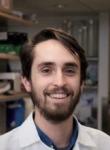Miller, Matthew

Matt is in the Immunity, Microbes, & Molecular Pathogenesis home area of the MBIDP, and joined the CMB training program in 2019. He received a B.S. in Molecular Environmental Biology from UC Berkeley.
Mentor: Dr. Manish Butte
How solid tumors thrive despite an intact adaptive immune response has been a pressing dilemma in the field of immunology. Tumor antigen-specific T cells are found within melanomas, yet these tumors continue to grow. Competition for nutrients in the tumor microenvironment (TME) can significantly contribute to T-cell hyporesponsiveness. To thrive, both tumor cells and activated T cells depend on aerobic glycolysis for expansion, a cellular program that optimizes the glycolytic pathway despite the presence of abundant oxygen to support glucose catabolism via the tricarboxylic acid (TCA) cycle and oxidative phosphorylation. While apparently less efficient at energy production, the intermediates generated during glycolysis are shunted into different anabolic pathways for the synthesis of macromolecules essential for cell growth and division. As a result, both tumors and tumor infiltrating lymphocytes are glucose avid, expelling copious amounts of lactate, the end-product of glycolysis, into the extracellular environment. The TME has been documented to contain upwards of 20 mM lactate with a concomitant drop in extracellular pH.
The goals of my project are to determine T-cell fuel preference and plasticity in the TME and to genetically engineer T cells to efficiently shuttle lactate carbons into the TCA cycle. To explore the impact of glycolytic intermediates and T cell fuel preference, I will develop an in vitro modeling system that replicates the depleted nutrient conditions and chronic activation signals seen in the TME. T cells will be pushed towards an exhausted state that is verified by staining extracellular surface markers and intracellular cytokines and then measured using flow cytometry. The metabolic profiles of exhausted T cells, including oxygen consumption rate and extracellular acidification, will be measured using a Seahorse FX analyzer. In addition, 13C-labelled glucose or lactate will be administered to cultured T cells and downstream isotopometric liquid chromatography-mass spectrometry will be performed. To engineer T cells to oxidize lactate we will overexpress LDHB cDNA in activated mouse T cells using the murine stem cell virus and co-express green fluorescent protein (GFP). LDHB has been reported to have an equilibrium constant that favors pyruvate formation, compared to highly expressed LDHA. Sorted LDHBhi cells will be cultured in various metabolic contexts, including low glucose and lactate at ranges including 0-20 mM. We expect that compared to controls, LDHBhi cells will show diminished intra- and extracellular lactate, in addition to increased cellular proliferation, cytokine production, and mitochondrial oxygen consumption.


